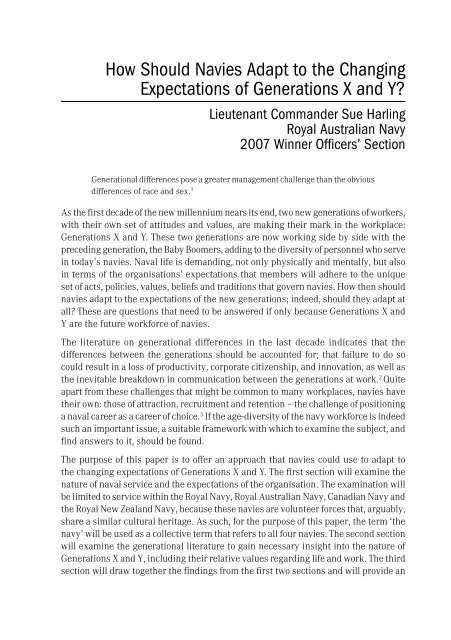Australian Maritime Issues 2007 - Royal Australian Navy
Australian Maritime Issues 2007 - Royal Australian Navy
Australian Maritime Issues 2007 - Royal Australian Navy
You also want an ePaper? Increase the reach of your titles
YUMPU automatically turns print PDFs into web optimized ePapers that Google loves.
How Should Navies Adapt to the Changing<br />
Expectations of Generations X and Y?<br />
Lieutenant Commander Sue Harling<br />
<strong>Royal</strong> <strong>Australian</strong> <strong>Navy</strong><br />
<strong>2007</strong> Winner Officers’ Section<br />
Generational differences pose a greater management challenge than the obvious<br />
differences of race and sex. 1<br />
As the first decade of the new millennium nears its end, two new generations of workers,<br />
with their own set of attitudes and values, are making their mark in the workplace:<br />
Generations X and Y. These two generations are now working side by side with the<br />
preceding generation, the Baby Boomers, adding to the diversity of personnel who serve<br />
in today’s navies. Naval life is demanding, not only physically and mentally, but also<br />
in terms of the organisations’ expectations that members will adhere to the unique<br />
set of acts, policies, values, beliefs and traditions that govern navies. How then should<br />
navies adapt to the expectations of the new generations; indeed, should they adapt at<br />
all? These are questions that need to be answered if only because Generations X and<br />
Y are the future workforce of navies.<br />
The literature on generational differences in the last decade indicates that the<br />
differences between the generations should be accounted for; that failure to do so<br />
could result in a loss of productivity, corporate citizenship, and innovation, as well as<br />
the inevitable breakdown in communication between the generations at work. 2 Quite<br />
apart from these challenges that might be common to many workplaces, navies have<br />
their own: those of attraction, recruitment and retention – the challenge of positioning<br />
a naval career as a career of choice. 3 If the age-diversity of the navy workforce is indeed<br />
such an important issue, a suitable framework with which to examine the subject, and<br />
find answers to it, should be found.<br />
The purpose of this paper is to offer an approach that navies could use to adapt to<br />
the changing expectations of Generations X and Y. The first section will examine the<br />
nature of naval service and the expectations of the organisation. The examination will<br />
be limited to service within the <strong>Royal</strong> <strong>Navy</strong>, <strong>Royal</strong> <strong>Australian</strong> <strong>Navy</strong>, Canadian <strong>Navy</strong> and<br />
the <strong>Royal</strong> New Zealand <strong>Navy</strong>, because these navies are volunteer forces that, arguably,<br />
share a similar cultural heritage. As such, for the purpose of this paper, the term ‘the<br />
navy’ will be used as a collective term that refers to all four navies. The second section<br />
will examine the generational literature to gain necessary insight into the nature of<br />
Generations X and Y, including their relative values regarding life and work. The third<br />
section will draw together the findings from the first two sections and will provide an
















